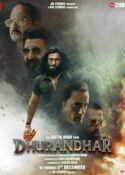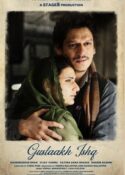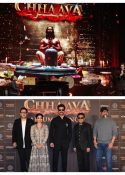 Subhash K Jha in a special edition of his THIS day That Year feature series focusses on not one but two films… Ramesh Sippy’s classic Sholay that released in 1975 and the 2007 remake by Ram Gopal Varma titled Aag.
Subhash K Jha in a special edition of his THIS day That Year feature series focusses on not one but two films… Ramesh Sippy’s classic Sholay that released in 1975 and the 2007 remake by Ram Gopal Varma titled Aag.
Ram Gopal Varma’s Aag is the worst re-make you’re likely to see.Ram Gopal Varma’s remake of Sholay doesn’t claim to have the wherewithal, the stock, substance and spice of Ramesh Sippy’s Sholay.
Let’s just call Aag an audacious revisionist version of “Sholay” and be done with it. The biggest mistake we can make while watching Varma go back to his favourite film is to look for signs and symbols from the past. Varma is to blame for doing some sequences as parodic homages to Sippy’s Sholay. Bachchan as Babban does the ‘Kitne aadmi the’ scene like a rude game of Russian roulette with the stakes being life and death.
Trouble is, Ramu treats the classic material with an iconoclastic take-it-or-edit-it-out casualness. Some of the original’s most celebrated sequences, like Jai going to Basanti’s Mausi with Veeru’s rishta, have been defiantly subverted to suit the stench of gangsterism that Varma’s cinema embraces almost intuitively.Every time he looks at human relations within a specific socio-political context, it’s almost always the underworld.
The biggest failing of Varma’s revisionist Sholay is its locational dereliction. The action unfolds in a series of indeterminate locations, mainly run-down warehouses, half-constructed high-rise buildings and sets that seem to suggest nothing beyond the immediate present that exists between the ‘action’ and ‘cut’.
Cut to Sippy’s Sholay where the boulder-centric locations defined the outlaw’s menacing evil with geo-political accuracy… or the Thakur’s bustling family-home where the villain’s savage carnage occurred.
Here the slaughter of the police inspector’s family is strictly ritualistic-designed to shock rather than create a drama of dread and vendetta. Bachchan invests the villain Gabbar’s part with loads of nuanced diabolism, wacky humour and seemingly casual one-liners.
Sanjeev Kumar’s chopped hand from Sholay become Mohanlal’s severed fingers in Aag. The silently weeping-widow Radha from the 1975 classic is transformed into a militant medico. And the post-Holi dacoit’s attack in Sholay becomes a Diwali mayhem in “Aag”. Inexcusably, the action scenes and the camera work (by Amit Roy) don’t seem to liven up the luminous antecedents of this purported homage to a timeless film.
Barring one major sequence between Babban and his morally antithetical brother (Sachin), some light moments between Ghungroo, the auto-rickshaw siren, and Rehmat, the blind Muslim patriarch’s playful son, and some perfunctory scenes between Mohanlal and Sushmita, the inter-relationships among the characters just don’t hold together.
Specially damaging to the neo-plot is the complete lack of camaraderie between the new-millennium Jai and Veeru, now known as Raj and Heero. Devgan and newcomer Prashant Raj look like acquaintances who have recently met at a railway station. Simply playing ‘Yeh dosti’ as part of the background score doesn’t help create any bonding between the supposed buddies.
No, I am not going to think about the warm vibes between Bachchan and Dharmendra in Sholay… or the chemistry between Veeru and Basanti, reduced here to a touchy-touchy liaison between Devgan and Nisha Kothari. I’d still run back and view Ramu’s revisionist Sholay for the pleasure of watching Bachchan flick his tongue over his lips in a mix of menace and mischief. Varma has steered the original material through murky waters to give Sholay a new-age look, albeit a look that’s more bleak than bright.
Ram Gopal Varma’s Sholay is no more Sholay. It’s something else altogether. According to extremely reliable sources Ram Gopal Varma has entirely revamped, refurbished and re-dressed almost all the immortal characters from Ramesh Sippy’s historical epic. In fact, the relationships that bound the memorable characters in the 1975 epic have also been completely moved around to suit the dark contemporary underworld milieu where Ramu has situated his film. The mute widow-in-white Radha played by Jaya Bachchan in the earlier kitsch-classic is now named Devi. And she no longer wears white, but sparkling black. According to Ramu’s Sholay she’s no longer the Thakur’s silently grieving daughter-in-law but the Inspector Ranveer (Mohanlal) ‘s brother’s widow. Ramu’s Devi, a trained nurse, is far more aggressive in her desire for revenge than Radha could’ve ever been. Her relationship with one of the two mercenaries who are hired by Ranveer to exterminate the gangster and his goons, also takes a course quite different from Sippy’s Sholay. Hema Malini’s extroverted loud tangewali Basanti in Sholay transforms in Ramu’s Sholay into Ghungroo, to be played by Nisha Kothari, the only female auto-rickshaw driver in Mumbai who throws attitude like a male but is actually all feminine at heart. Deviating completely from Basanti’s tonga and horse Dhanno, Ghungroo’s auto which she has named Laila in Ramu’s film is going to be a state-of-the-art creation. Said a source, “Ghungroo’s tonga will be an art-director’s nightmare. It would contain several hangings , multi-speaker music system with synchronized disco lights , leopard print upholstery and a large image of Durga, all within the confines of the miniature auto.” Most interestingly, while the widow Radha and the outspoken and flamboyant Basanti never came together in Sippy’s film (because Hema Malini never wanted to be seen anywhere near Sanjeev Kumar who played the widow’s father-in-law, as Sanjeev had proposed to Hema ), Devi and Ghungroo are very close friends…a cinematic subversion that cheekily echoes Paro and Chandramukhi’s unprecedented bonding in Sanjay Leela Bhansali’s Devdas! Apart from these characters the two male protagonists Jai and Veeru are also being seriously revamped and modified to suit the requirements of Ramu’s new-age Sholay.








